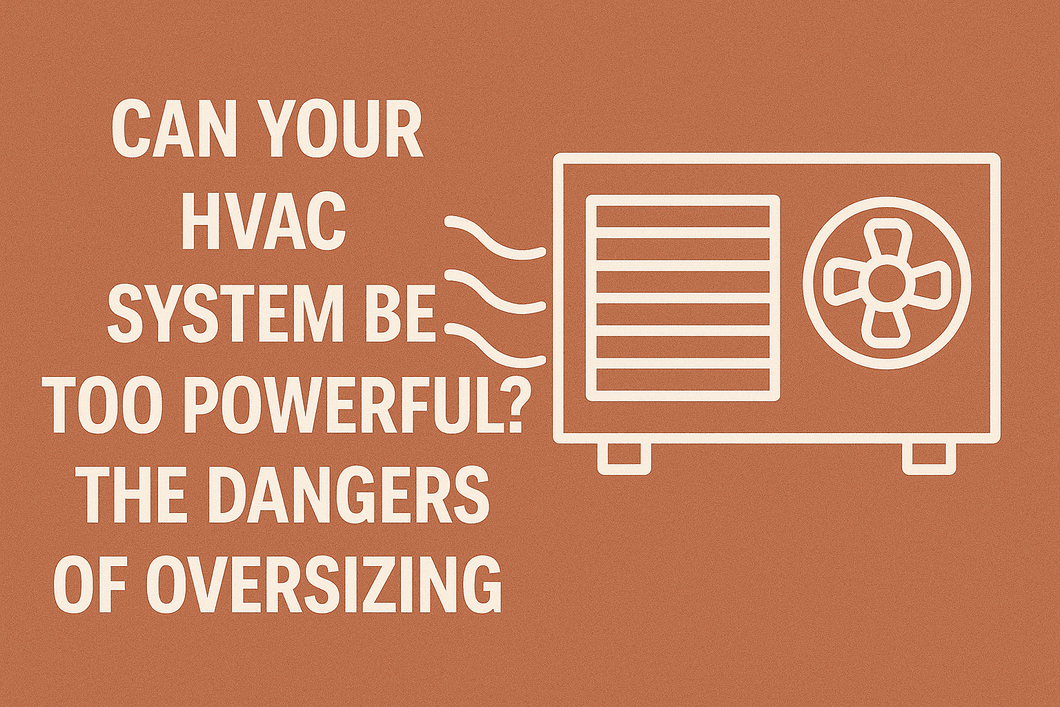When it comes to heating, ventilation, and air conditioning, most homeowners assume that bigger means better. A larger HVAC system seems like it would deliver more comfort, quicker heating and cooling, and longer-lasting equipment. However, oversizing your HVAC system can actually be one of the most costly mistakes a homeowner can make. At first, it may not seem obvious, but an HVAC unit that is too powerful for your space can lead to inefficiency, high utility bills, and long-term damage to your home’s comfort and structure.
In this guide, we’ll dive deep into the dangers of an oversized HVAC system, how to recognize the signs, and what steps you can take to ensure your system is properly sized for your home.
What Does It Mean for an HVAC System to Be Oversized?
An HVAC system is considered oversized when its capacity to heat or cool exceeds the actual load requirements of the home. Instead of running in steady, efficient cycles, an oversized system operates in short bursts, rapidly cooling or heating the air and then shutting down. This process is known as short cycling, and it is the root cause of most oversizing issues.
The Hidden Dangers of an Oversized HVAC System
1. Short Cycling and Wasted Energy
When an HVAC system is too powerful, it reaches the thermostat setting too quickly. While this may sound efficient, it actually causes the system to cycle on and off far more often than necessary.
- Each start-up consumes more energy than continuous operation.
- Frequent cycling places extra wear on motors, compressors, and other components.
- Utility bills rise as efficiency plummets.
2. Poor Humidity Control
Comfort is not just about temperature—it’s also about humidity balance. An oversized air conditioner cools the air quickly but doesn’t run long enough to properly remove moisture. The result?
- Higher indoor humidity.
- Increased risk of mold, mildew, and dust mites.
- A clammy, uncomfortable feeling even when the air is cool.
3. Uneven Temperatures and Hot/Cold Spots
Oversized systems push large volumes of air quickly, but they fail to distribute it evenly. Some rooms may cool or heat rapidly, while others remain uncomfortable. Homeowners often notice:
- Hot upstairs rooms while the downstairs is freezing.
- Drafty areas near vents.
- Constant thermostat adjustments to chase comfort.
4. Increased Wear and Tear
Because oversized HVAC units cycle more often, they wear out faster than properly sized systems. Components such as fans, compressors, and relays undergo excessive stress. This can lead to:
- Frequent repairs.
- Shortened system lifespan.
- Costly premature replacements.
5. Higher Upfront and Ongoing Costs
Many homeowners overspend by purchasing larger equipment unnecessarily. Not only is the initial price tag higher, but the long-term costs from inefficiency, maintenance, and repairs can add up to thousands of dollars over time.
How Oversizing Impacts Indoor Air Quality
A hidden danger of oversizing is the effect it has on indoor air quality. Since the system doesn’t run long enough, it fails to properly filter dust, allergens, and airborne particles. Homeowners may experience:
- More dust accumulation.
- Worsening allergy symptoms.
- Increased risk of respiratory issues.
Properly sized systems circulate and filter air more consistently, keeping your home healthier.
Signs That Your HVAC System May Be Too Powerful
If you’re wondering whether your HVAC system is oversized, look for these warning signs:
- Short run times: The system turns on and off frequently, often within just a few minutes.
- Inconsistent comfort: Certain rooms feel too hot or too cold.
- High humidity levels: The air feels damp and sticky despite cooling.
- Excessive noise: Large systems often sound louder because of higher airflow.
- High energy bills: Even with modern equipment, your bills don’t reflect energy savings.
The Science of HVAC Sizing
Proper HVAC sizing requires a Manual J Load Calculation, a process performed by professional contractors. This calculation considers:
- Square footage of the home.
- Insulation levels.
- Number and size of windows and doors.
- Local climate conditions.
- Occupancy and lifestyle habits.
Skipping this step often leads to incorrect system sizing, especially when homeowners or contractors rely on rules of thumb like “tons per square foot.”
Why Properly Sized Systems Perform Better
Consistent Comfort
Right-sized systems run in longer cycles, ensuring every corner of the home maintains a stable temperature.
Better Humidity Control
Longer run times allow the system to extract moisture, keeping humidity at safe and comfortable levels.
Energy Efficiency
Steady, optimized operation uses less energy than constant short cycling, reducing utility costs.
Longer Equipment Lifespan
Less stress on components extends the life of your HVAC system, protecting your investment.
The Role of Zoned Systems in Large Homes
For homeowners with large or multi-story homes, oversizing is often mistakenly chosen as the solution. Instead, zoned HVAC systems or multiple smaller units are far more effective. Zoned systems allow:
- Independent temperature control for different areas.
- More even distribution of heating and cooling.
- Greater efficiency without oversizing a single unit.
What to Do If Your System Is Oversized
If you suspect your HVAC system is too powerful, here are steps you can take:
- Schedule a professional load calculation to confirm the issue.
- Consider system modification, such as adding variable-speed controls to mitigate oversizing.
- Explore zoning solutions to divide cooling/heating loads more effectively.
- Plan for replacement if your oversized system is nearing the end of its lifespan.
Conclusion: Bigger Is Not Always Better
When it comes to HVAC systems, power and comfort don’t always go hand in hand. Oversizing creates a host of problems, from poor humidity control and uneven temperatures to excessive energy bills and system breakdowns. The key to true comfort lies in precision sizing, ensuring that your system is matched to your home’s unique needs.
By working with a qualified HVAC professional, you can avoid the pitfalls of oversizing and enjoy a home that is truly comfortable, energy-efficient, and healthy.


